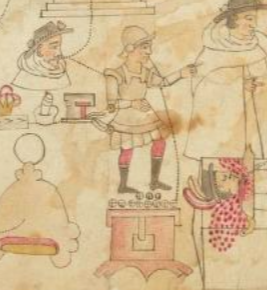caja (Azca31)
We are labeling this unglossed painting of a treasury chest as a “caja,” which means a chest and is a term that was taken into Nahuatl alphabetic manuscripts as a loanword. This chest is probably made of wood (the parts painted red or dark pink). It also has some hardware that probably serves as a locking apparatus (painted tan). Under the chest are four curving legs. Sitting atop the chest are eleven Spanish coins (probably pesos, given the crosses on them).
Stephanie Wood
The contextualizing image shows dotted lines connecting this treasury chest to a Spaniard in armor who is also connected to another Spaniard who may be a priest, for he is connected to a church. Seemingly the money from the chest was to be spent on the church or a saint’s day. See below for a comparison of this caja with the caja cuahuitl (specifically called a wooden box or chest) from the Codex Sierra-Texupan (CST). Another contribution from that manuscript is what was simply called a caja (CST31), but that one looks smaller and less fortified than this one.
Stephanie Wood
post-1550, possibly from the early seventeenth century.
Jeff Haskett-Wood
cajas, dinero, tesorería de la comunidad
caja, a treasury chest (loanword from Spanish), https://nahuatl.wired-humanities.org/content/caja
la caja de comunidad
Stephanie Wood
The Codex Azcatitlan is also known as the Histoire mexicaine, [Manuscrit] Mexicain 59–64. It is housed in the Bibliothèque Nationale de France, and hosted on line by the World Digital Library and the Library of Congress, which is “unaware of any copyright or other restrictions in the World Digital Library Collection.”
https://www.loc.gov/resource/gdcwdl.wdl_15280/?sp=31&st=image
The Library of Congress is “unaware of any copyright or other restrictions in the World Digital Library Collection.” But please cite Bibliothèque Nationale de France and this Visual Lexicon of Aztec Hieroglyphs.



